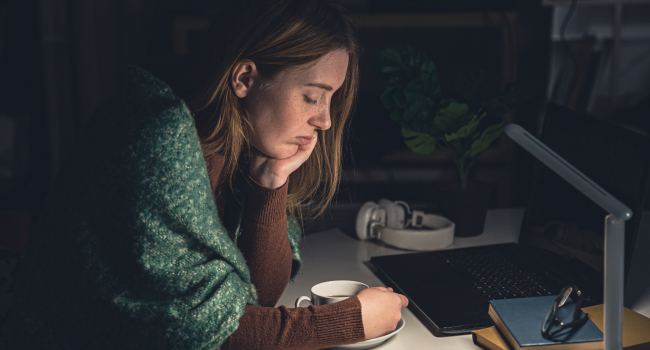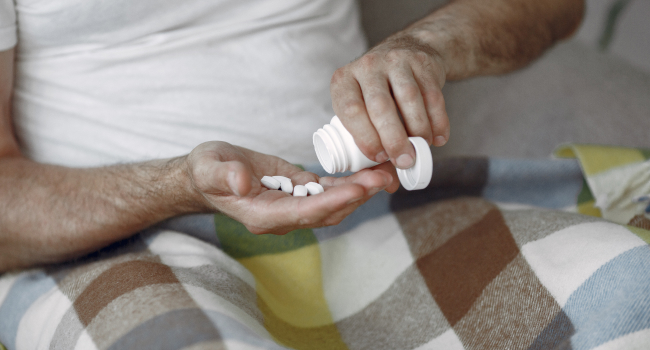Their inclusion does not guarantee they will be prescribed to any individual, as treatment decisions are ultimately at the discretion of healthcare providers. Healthcare providers may prescribe other medications or recommend non-pharmacological treatment based on the patient’s unique health circumstances and needs. Read more
Doxepin has a
Highlights
- Low-dose doxepin (sold under the brand name Silenor) is FDA-approved for treating insomnia, and specifically helps with staying asleep through the night rather than falling asleep faster.
- Unlike many other sleep aids, doxepin is not addictive and has a low risk of withdrawal symptoms.
- Low-dose doxepin generally does not cause morning grogginess or impair next-day functioning, a common concern with other sleep medications.
- Although rare, doxepin may worsen depression or increase the risk of suicidal thoughts, particularly in younger adults.
Experts recommend getting
When sleep doesn’t come easily, it can affect everything from your mood to your immune system. The good news? There are treatments that can help. One option your doctor might suggest is doxepin — a medication that’s been found to be effective in people who have trouble sleeping. In this guide, we’ll walk you through what doxepin is, how it works, and what to know before using it to help you get a good night’s sleep.
What Is Doxepin?
But for people dealing with chronic insomnia, research shows that low-dose doxepin tablets are effective for
Doxepin for Sleep
Doxepin was originally developed as an antidepressant. It works by affecting chemical messengers (neurotransmitters) in the brain, such as norepinephrine and serotonin, which are linked to mood regulation. But for sleep, doxepin is typically prescribed in very low doses of 1 to 6 mg at bedtime. At these doses, it works differently than when used for depression. Instead of affecting mood, it helps block histamine (a chemical in the brain that helps regulate wakefulness).
Unlike other sleep aids that are primarily used to improve sleep onset (falling asleep faster), doxepin is designed to help you

How Long Should You Take Doxepin for Sleep?
When using doxepin for insomnia, sleep typically begins to improve within the first few nights of use. It is typically used for 4 to 8 weeks, but clinical trials in older adults have shown that doxepin can be safely and effectively used nightly for
Most patients start to feel its sedative effects, such as increased drowsiness, within 30 minutes to an hour after taking it. As with other sleep aids, if you don’t notice an improvement in sleep or if sleep worsens over the next 7 to 10 days, you should talk with your healthcare provider.
Doxepin Dosage
The recommended dose of doxepin is 3 mg to 6 mg once daily, 30 minutes before bed. Because food can delay the onset of doxepin’s effects, it is recommended to avoid eating a heavy meal within 3 hours before taking your dose of doxepin.
Only take doxepin if you are able to get a full night’s sleep (
Doxepin Withdrawal
Withdrawal symptoms are more commonly linked to higher doses of doxepin, where the medication acts more strongly on neurotransmitters in the brain. At those higher levels, stopping the medication suddenly can lead to symptoms like nausea, fatigue, headache, sleep disturbances, and mood changes.
When used specifically for sleep, doxepin is prescribed as its low-dose form called Silenor. Due to this lower dose, the risk of withdrawal symptoms is much lower than with higher doses of doxepin used to treat depression or anxiety. In fact, studies show that when using doxepin for insomnia, suddenly stopping it
Doxepin Side Effects
Doxepin may cause some mild side effects, but these are usually temporary and may go away as your body adjusts to the medication. Common
- Dizziness
- Drowsiness
- Upper respiratory tract infection
- Nausea
- Dry mouth
Serious side effects aren’t common, but they can occur. In some people, doxepin may worsen depression or increase the risk of suicidal thoughts, particularly in younger adults.

In rare cases, doxepin may cause unusual sleep-related behaviors that you do not know you are doing, such as sleep-driving, sleep-walking, having sex, talking on the phone, and even preparing and eating food. You may not remember doing any of these. Certain risk factors, such as taking other sedating medications or consuming alcohol, may increase the likelihood of these events.
If you’re experiencing suicidal or self-harming thoughts and require immediate assistance, contact a crisis hotline, such as 911, 988 suicide & crisis lifeline (toll-free), or Samaritans (116-123 or via chat).
Overdose Risks
Doxepin, like all prescription medications, can be dangerous if taken in large amounts. Although Silenor for insomnia is a low-dose form of doxepin and serious side effects or overdose are rare, it’s important to know the signs. Symptoms of doxepin overdose may
- Confusion
- Abnormal heart rhythm
- Trouble concentrating
- Hallucinations
- Seizures
- Sleepiness
- Vomiting
- Muscle stiffness
To stay safe, always take Silenor exactly as prescribed and keep it out of reach of children or anyone for whom it wasn’t intended. If you ever suspect an overdose, seek medical attention right away, even if symptoms seem mild at first.
Precautions
Doxepin may not be right for everyone. Tell your healthcare provider if you have any medical conditions, including:
- Heart disease
- Narrow-angle glaucoma
- A previous allergy to doxepin or any of its ingredients
- Kidney or liver problems
- Severe sleep apnea
- Severe urinary retention (trouble urinating)
Also, make sure to inform your medical provider if you are pregnant or breastfeeding (or planning to become pregnant or breastfeed) as it’s important for choosing the right treatment.
Interactions
Food and Alcohol Interactions
Taking doxepin with or immediately after a meal may reduce its effectiveness or cause you to feel tired the next day. Do not take doxepin within 3 hours of a meal.
Avoid drinking alcohol while taking doxepin. Doxepin can make you sleepy and less aware, and drinking alcohol can worsen this side effect.
Drug Interactions
One of the most important things to avoid when taking doxepin is combining it with other central nervous system depressants. Otherwise, there is an increased risk of excessive drowsiness, dizziness, confusion, and impaired coordination. Some of the medications to avoid include:
- Benzodiazepines (like diazepam, lorazepam, alprazolam)
- OTC sleep aids such as diphenhydramine (found in Benadryl, Tylenol PM, ZzzQuil) or doxylamine (found in Unisom)
- Sleep medications (like zolpidem, eszopiclone, or zaleplon)
- Muscle relaxants (such as cyclobenzaprine, carisoprodol)
- Certain antipsychotics or mood stabilizers that also have sedating effects
- Opioids (such as oxycodone or hydrocodone)
- Other tricyclic antidepressants (TCAs), such as amitriptyline or nortriptyline
In addition, avoid taking doxepin with monoamine oxidase inhibitors (MAOIs), or using them within 14 days of each other, such as isocarboxazid, phenelzine, linezolid, rasagiline, or selegiline. Combining them could lead to serious and potentially life-threatening reactions, including high blood pressure, agitation, or seizures.
Several other medications can interact with doxepin, which means it might change how they or doxepin work in your body. These include:
- Cimetidine
- Other antidepressants, including bupropion or selective serotonin reuptake inhibitors (SSRIs), such as sertraline, paroxetine, or fluoxetine
- Certain antibiotics, such as clarithromycin or erythromycin
Be sure to tell your healthcare provider about all the medications, including supplements and vitamins, that you are currently taking before starting doxepin.
Comparison to Other Sleep Medications
Doxepin (Silenor) works differently from many other common insomnia treatments. That difference can be a good thing when it comes to the safety of doxepin, especially for long-term use. Unlike “Z-drugs” such as zolpidem (Ambien) or eszopiclone (Lunesta), doxepin doesn’t act directly on GABA receptors in the brain. This means it’s less likely to cause dependence, next-day grogginess, or withdrawal symptoms.
Trazodone is also an antidepressant sometimes prescribed for sleep. However, it isn’t FDA-approved to treat insomnia, meaning it hasn’t been specifically studied for this use. While trazodone can be sedating, it may cause more side effects like morning drowsiness or changes in blood pressure.
Cost & Availability
The cost of doxepin can vary based on your location, the pharmacy you choose, your insurance coverage, and whether you use any discount programs or cards.
While the brand-name version (Silenor) can cost around $640 for a 30-day supply, the generic typically costs from $214 to $350 without insurance. Many insurance plans cover doxepin, often requiring only a small copay, though the exact amount will depend on your specific plan.
Ways to Save
- Use pharmacy discount cards such as GoodRx.
- Look for digital coupons on websites such as Optum Perks, SingleCare, or BuzzRx.
- Look into member savings programs at stores like Costco and Sam’s Club, which can provide extra discounts on prescription medications.
Final Word
Low-dose doxepin (Silenor) is a prescription medication used to treat insomnia. It has
Low-dose doxepin is generally well tolerated, but like all medications it can interact with other drugs, especially those that also cause drowsiness. So, it’s important to talk with your healthcare provider about the medications you are currently taking. Contact MEDvidi to see a licensed clinician who can assess your symptoms, make a diagnosis, and provide an online prescription for a medication that will suit you best.
Frequently Asked Questions
Is it okay to take doxepin every night?
How much doxepin can you take for sleep?
To treat insomnia, the typical dose is 3 mg or 6 mg taken about 30 minutes before bedtime.
How long does it take for doxepin to work for sleep?
Is doxepin addictive?
No, low-dose doxepin is not considered addictive and is not a controlled substance. It has a low risk of dependence, unlike some other sleep medications such as benzodiazepines or Z-drugs.
Can I take 20 mg of doxepin for sleep?
Doses of 20 mg or higher aren’t recommended for insomnia due to the increased risk of side effects (such as nausea, drowsiness, confusion, and next-morning sedation) without being more effective for sleep.
Is Silenor a good sleeping pill?
Yes, Silenor is effective for people who have trouble staying asleep. It’s been shown to increase sleep duration, is well tolerated, non-addictive, and doesn’t typically cause next-day grogginess.
Which is better for sleep: trazodone or doxepin?
Both are used for sleep, but doxepin (at low doses) is FDA-approved specifically for insomnia, while trazodone is often used for sleep off-label. Doxepin may cause fewer side effects like grogginess, and is less likely to impact blood pressure. The better option will depend on your individual needs.












